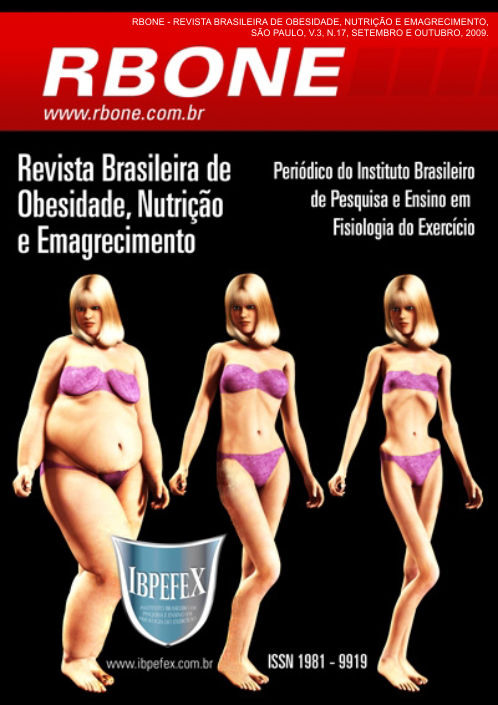Prevalence of metabolic syndrome in patients of offices
Abstract
The objective of this paper is to characterize the prevalence of metabolic syndrome in patients of offices in the city of Divinópolis during the period of 2005-2007. Method: A selection through an electronic archive has been made during two years. Measurements of the (body mass index (BMI), the relation between the measure of the waist and the hip (RCQ), the systolic arterial pressure (SAP) and the diastolic (DAP), the levels of glicemy during fasting, total cholesterol and triglycerides, have benn colected. Results: The prevalence of the hypertension in the men group has increased from 15,3% (in the overweight individuals –BMI 25 –29.9 kg/m²) to 87% in patients with obesity of the third degree (BMI ≥ 40 Kg/ m² m²). In the female population the raise from 33.3% (in the overweight group –BMI 25-29.2 kg/ m²) to 42.3 % in patients with the obesity of the third degree (BMI ≥40 kg/m²) hasn’t been so expressive. 56% of the patients that belong to the total of the analyzed population are carrying on the metabolic syndrome. Conclusion: The metabolic syndrome has become more common in the population. The excess of corporal fat, the hypertension and the dyslipidemia are closely related to the metabolic syndrome. However, the appropriate feeding combined to other modifications in the life style, such as regular practice of physical activity, the consumption of healthy food will contribute for a better control of the disease.
References
-Colditz, G.A.; Willett, W.C.; Rotnitzky A.; Manson, E. Weight gain as risk factor for clinical diabetes mellitus in women. Annals of Internal Medicine. Vol. 122. Num.7, 1995. p. 481-486.
-Consenso Brasileiro de Hipertensão Arterial –III Consenso Brasileiro de Hipertensão Arterial-1998.
-Desouza, C.; Gilling, L.; Fonseca, V. Management of the insulin resitance síndrome. Curr Diab. Rep. Vol. 1. Num. 2. 2001. p. 140-147.
-Han, T.S.; Sattar, N.; Williams, K.; Gonzalez-Villalpando, C.; Lean, M.E.J.; Haffner, S.M. Prospective study of C-reative protein in relation to the development of diabetes and metabolic syndrome in the Mexico City Diabetes Study, Diabetes Care. Vol. 25. Num. 11. 2002. p. 2016-2021.
-Jung, R. Obesity as a disease. British Medical Bulletin, London. Vol. 53. Num. 2. 1997. p. 307-321.
-Kaplan, N.M. Obesity in hypertension:effects on prognosis and treatment. J. Hypertension. Vol. 16. suppl 1. 1998. p. 35-37.
-Misra, A. Insulin resistence syndrome: Current perspective and its relevance in Indians. Indian Heart. J. Vol. 50. 1998. p. 385-395.
-Oliveira, L.C.; Mello, T.M.; Cintra, P.I.; Fisberg, M. Obesidade e síndrome metabólica na infância e adolescência. Rev. Nutr. Vol. 17. Num. 2. abr/jun. 2004. p. 237-245.
-Pinheiro, O.R.A.; Freitas, T.F.S.; Corso, C.T.C.A. Uma abordagem epidemiológica da obesidade. Rev. Nutr. Vol. 17. Num. 4. 2004. p. 523-533.
-Pitsavos, C.; Panagiotakos D.; Chrysohoou, C.; Papadimitriou, L.; Tousoulis, D.The Adoption of Mediterranean diet attenuates the development of acute coronary syndromes in people with the metabolic syndrome. Nutr J. Vol. 2. Num. 1. 2003. p. 1-7.
-Posner, B.M. Preventive intervention in coronary heart disease. Perspective in pratice. Vol. 86. 1986. p. 1395-1401.
-Reaven, G.M. Insulin reistence, hyperinsulinemia, hypertrigliceridemia in the clinical course of hypertension. J. Méd. Vol. 90. Num. 75. 1991. p. 75-121.
-SBH –Sociedade Brasileira de Hipertensão, SBC –Sociedade Brasileira de Cardiologia, SBEM –Sociedade Brasileira de Endocrinologia e Metabolismo, ABEO –Associação Brasileira para Estudos da Obesidade. I Diretriz brasileira de diagnóstico e tratamento da síndrome metabólica. Vol. 7. Num. 4. 2004. p. 130-159.
-Selby, J.V.; Friedman, G.D.; Quwsenberry, C.P.Jr. Precursors of essential hypertension. The role of body fat distribution pattern. Am. J. Epidemiol. Vol. 129. 1989. p. 43-53.
-Sociedade Brasileira de Cardiologia. Programa nacional de prevenção e epidemiologia, 1999.
-Van Gaal, L.F.; Zhang, A.; Steijaert, M.M.; Leeuw, I.H. Human obesity: from lipid abnormalities to lipid oxidation. Int. J. Obesity, Vol. 19. 1999. p. 5216.
-Wold Health Organization. Obesity: Preventing and managing the global epidemic. Report of a WHO Consultation on Obesty. Genova; 1998.
Authors who publish in this journal agree to the following terms:
- Authors retain the copyright and grant the journal the right of first publication, with work simultaneously licensed under the Creative Commons Attribution License BY-NC which allows the sharing of the work with acknowledgment of the authorship of the work and initial publication in this journal.
- Authors are authorized to enter into additional contracts separately for non-exclusive distribution of the version of the work published in this journal (eg, publishing in institutional repository or book chapter), with acknowledgment of authorship and initial publication in this journal.
- Authors are allowed and encouraged to post and distribute their work online (eg, in institutional repositories or on their personal page) at any point before or during the editorial process, as this can bring about productive change as well as increase impact and impact. citation of published work (See The Effect of Free Access).






